We here at TEXPERS know that the media live on controversy,
confrontation, and schism wherever they can find it. It’s called “making
headlines” and that is how they create a product that sells to an audience,
that then can be turned into advertising dollars.
We understand that dynamic and we appreciate the work that
the media does in bringing issues and events to our attention. We, as free
citizens, need the media telling us all what is going on around us. And we
realize that, without the sizzle of a sexy headline, people wouldn’t read the
newspaper and so there wouldn’t be any newspaper. The headline “20,000 planes
took off and landed again safely today” would get boring day after day, which
is why the media only focuses on the one that might, unfortunately, crash every
year and a half or so.
Such is the case with a story that featured TEXPERS’
activities on its members’ behalf at our summer conference which concluded this
week.
The story, “Groups
defend public pensions,” provided a summary of my and another TEXPERS’
member comments about special interest groups – all with funding coming from
outside of Texas – who have as their defining purpose the dissolution of
defined benefit plans for public employees. There’s no ‘give’ in their
position: No matter how well DB plans perform in Texas for police, firefighters
and municipal employees and the cities they work in, they must be replaced by
DC plans, they say. There’s no rational debate or discussion about the matter.
Just because some systems have not fared well in other parts of the country,
they must be dismantled here, our opponents say.
So, yes, we advised our members about these threats and the
reporter dutifully came to the one presentation where some hint of controversy
drew him to our conference. We’re not blaming him for doing that. It is his
line of work.
But what you should know is that, for the previous three
days, more than 500 trustees of pension systems from around the state came to
San Antonio to further their education about investments and pension
administration so that the burdens on taxpayers for their employees pensions
would be as low as possible. They heard from money managers, lawyers, and other
pensions, to learn how to operate the best possible pension, on their city’s
taxpayers behalf. Dedicated men and women took time from their personal lives
to devote their efforts to their colleagues at fire houses, police stations and
city halls across our great state. They came to invest their and their fellow’s
money as best they can so that after 20 or 30 years of service, at very minimal
rates of pay, the public employee could retire securely at least possible
burden to their fellow taxpayer.
In our view, this was the equivalent of the 20,000 planes
that cross our skies safely each day. It won’t make headlines, but it’s the
truth of what really happens with local pensions in Texas. -- Max Patterson
